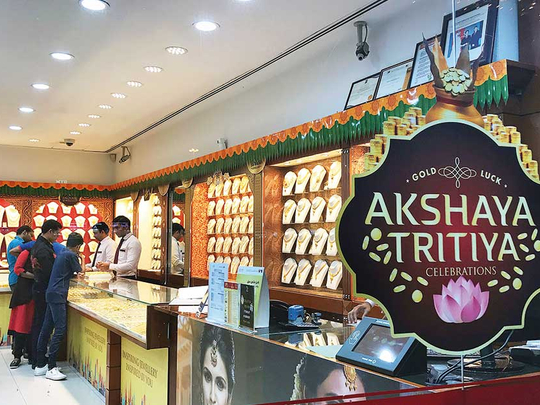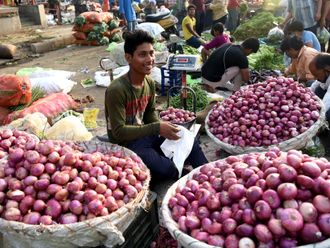
Dubai
Expatriate Indians in the UAE have a July to early January window of opportunity to make full use of the 13 per cent difference in gold prices between what they are here and in India. It becomes so after India’s new GST (goods and service tax) comes into effect from July 1, and which has been set at 3 per cent.
So, along with the 10 per cent import duty India charges on bullion, that works out to the 13 per cent price advantage at the retail level that buying gold in the UAE has for Indian shoppers. And that’s a fairly sizeable one at that — more so when gold prices head up. So far this year, gold has gained 12 per cent and could soon push through to $1,300 (Dh4,774) an ounce.
On Thursday, it started at $1,285.18 an ounce. In Dubai, a 22-carat gram was set at Dh147. In India, a gram started the day at Rs2,890. (One dirham was fetching Rs17.45 on Thursday.)
Even before the GST, UAE jewellers did have a variable double-digit advantage, but with GST in place, it becomes consolidated into a flat rate. (Earlier, different states in India used to have their own sales tax rates on gold and jewellery sales. For instance, in the southern Indian state of Kerala — home to one of the biggest gold consumers in the country — it used to be 5 per cent. With GST, it becomes a flat rate across India.)
But it will be what happens after January 2018 that UAE — and Gulf — jewellery retailers are looking to. Will UAE and Gulf implementation of VAT (value-added tax) on jewellery shrink the price advantage vis-a-vis India? As such, Indian buyers — residents and visitors — make up about 60-65 per cent of the gold and jewellery sales in these markets.
If VAT on jewellery is set at 5 per cent in the UAE, plus the 5 per cent import duty, that immediately translates into a higher retail price. Compared with the Indian prices, the cost advantage would drop to 3 per cent (removing other factors such as currency exchanges, etc).
“The Dubai Gold & Jewellery Group had made a presentation earlier this year to the Dubai authorities on its appraisal of VAT on jewellery in the UAE,” said Abdul Salam K.P, member of the Board of Directors and Treasurer at the Group. “We were told that the authorities in Dubai would relay our thoughts to their federal counterparts.
“Also, even if VAT on jewellery cannot be totally exempted, our request is that the authorities consider a system where VAT is charged only on the value-added portion of the jewellery piece. Even that would help the UAE’s jewellery sector retain a price advantage with the rest of the world on gold.” (This would mean that in a jewellery piece, if gold makes up 80-90 per cent and 10-20 per cent is the value-added, then VAT gets effected on the latter component alone.)
As things stand now, imports of gold — including investment bars — into the UAE are exempted from duty. Loose diamonds too are outside the purview. (For comparison’s sake, imports of jewellery into India are set at a steep 25 per cent, while for gold alone is 10 per cent.)
For the gold and jewellery trade here, the historic pricing advantage they offer compared with prices in the Subcontinent is all too critical. Any disruption in this — especially with the currency volatility for the Indian or Pakistani rupee — can impact on demand here.
“Even without the changes in taxes, the gold business in the UAE, especially Dubai, is becoming hyper-difficult,” said Joy Alukkas, chairman of the retail chain that bears his name. “You have multiple gold stores on every key street and the demand is not growing fast enough to sustain it.
“This is why future expansion for Joyalukkas will be focused more on locations in the other Gulf markets, plus add to our existing network in places such as the US, London, Australia and Singapore. That is anywhere with a sizeable Indian community. These buyers will retain their faith in gold come what may.” (In India, new Joyalukkas stores will target northern Indian markets rather than add more within its home base of Kerala.)
Whatever be the eventual VAT element on gold jewellery, industry sources say that after an initial reaction, shoppers will start accepting the additional surcharge. For them, the bigger concern would be whether gold pushes well past the $1,300 an ounce mark. If that happens, coupled with weak consumer sentiments, it could take away all the sparkle for the trade here.












